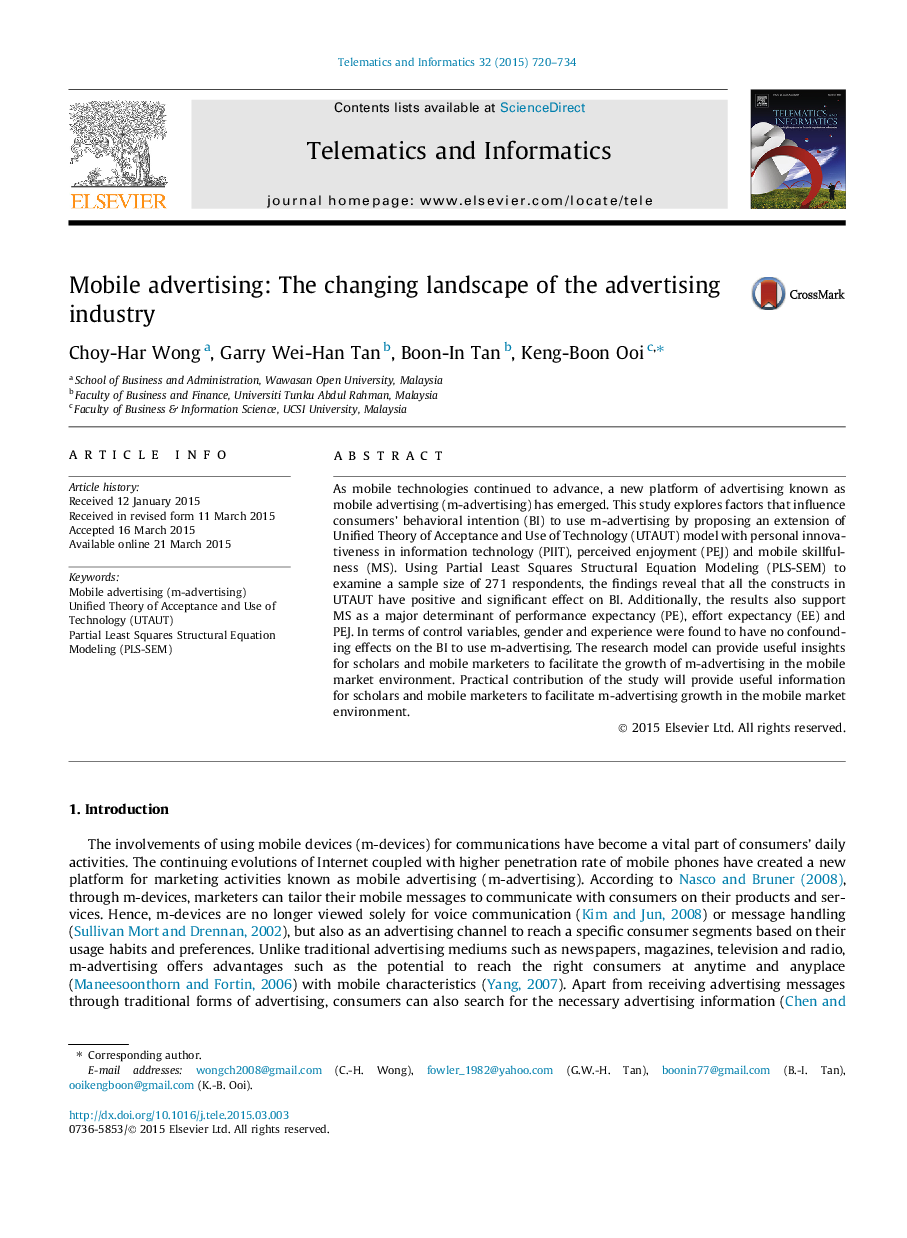| کد مقاله | کد نشریه | سال انتشار | مقاله انگلیسی | نسخه تمام متن |
|---|---|---|---|---|
| 466982 | 697894 | 2015 | 15 صفحه PDF | دانلود رایگان |
کلمات کلیدی
1. مقدمه
2. پیشینه نظری
2.1 پذیرش تبلیغات تلفن همراه
2.2. نظریه یکپارچه پذیرش و استفاده از فناوری
3. پیشرفت فرضیات
3.1 نوآوری شخصی در فن آوری اطلاعات (PIIT)
شکل 1. مدل تحقیقی
3.2 نفوذ اجتماعی (SI)
3.3 انتظار عملکرد (PE)
3.4 انتظار تلاش (EE)
3.5 شرایط تسهیل کننده (FC)
3.6 لذت ادراکی (PEJ)
3.7 مهارت موبایل (MS)
3.8 متغیرهای کنترل: جنسیت و تجربه
4. روش تحقیق
4.1 روش و رویکردهای نمونه گیری
4.2 ابزارهای نظر سنجی
4.3 تحلیل داده ها
4.3.1 مشخصات پاسخ دهندگان
جدول 1. منابع و آیتمهای پرسش در نظرسنجی.
جدول 2. مشخصات پاسخ دهندگان
4.3.2 تحلیل آماری
4.3.3 مدل اندازه گیری- خطای روش مشترک
4.3.4 تست مدل اندازه گیری
جدول 3. آزمون مدل اندازه گیری
4.3.5 آزمون فرضیه ها
جدول 4. تست اعتبار افتراقی
جدول 5. نتایج حاصل از آزمون فرضیه ها با استفاده از مدل یابی معادلات ساختاری حداقل مربعات جزئی
شکل 2. آزمون مدل تحقیق.
5. بحث و بررسی
6. مفاهیم
6.1 مفاهیم نظری
6.2 مفاهیم مدیریتی
7. محدودیت ها و تحقیقات آینده
8. نتیجه گیری
• The study explores the factors of m-advertising by proposing an extension of UTAUT.
• The constructs of UTAUT, FC and PEJ have positive and significant effect on BI.
• MS is a significant predictor for PE, EE and PEJ.
• EE has significant effect on PE.
• The control variables (gender and experience) have no confounding effects on BI.
As mobile technologies continued to advance, a new platform of advertising known as mobile advertising (m-advertising) has emerged. This study explores factors that influence consumers’ behavioral intention (BI) to use m-advertising by proposing an extension of Unified Theory of Acceptance and Use of Technology (UTAUT) model with personal innovativeness in information technology (PIIT), perceived enjoyment (PEJ) and mobile skillfulness (MS). Using Partial Least Squares Structural Equation Modeling (PLS-SEM) to examine a sample size of 271 respondents, the findings reveal that all the constructs in UTAUT have positive and significant effect on BI. Additionally, the results also support MS as a major determinant of performance expectancy (PE), effort expectancy (EE) and PEJ. In terms of control variables, gender and experience were found to have no confounding effects on the BI to use m-advertising. The research model can provide useful insights for scholars and mobile marketers to facilitate the growth of m-advertising in the mobile market environment. Practical contribution of the study will provide useful information for scholars and mobile marketers to facilitate m-advertising growth in the mobile market environment.
Journal: Telematics and Informatics - Volume 32, Issue 4, November 2015, Pages 720–734
